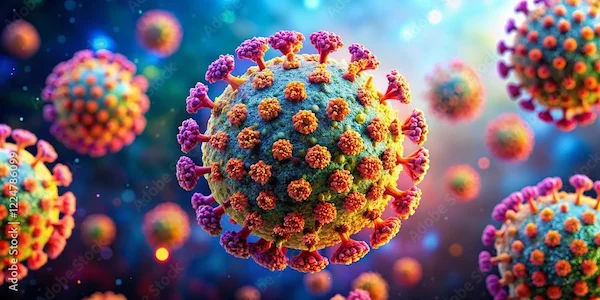What Leads To Signs Of Nipah Virus
Know about the Nipah virus, what it is, who is at risk, signs, symptoms, diagnosis, treatment options and management of Nipah virus.


Introduction
The emergence of a new outbreak can be a source of significant anxiety. Among the various viral threats, the Nipah virus stands out due to its high fatality rate and the severity of its symptoms. But what exactly leads to the signs of a Nipah virus infection? This article will demystify the Nipah virus, breaking down the critical links in the chain of infection that result in its alarming symptoms. We will explore its animal origins, how it transmits to people, the progression of the disease from initial fever to potentially fatal encephalitis, and the crucial measures you can take to stay protected. By the end, you will have a clear picture of the causes behind the signs, empowering you with knowledge in the face of this public health challenge.
What is the Nipah Virus? A Zoonotic Threat
The Nipah virus (NiV) is a zoonotic pathogen, meaning it is transmitted from animals to humans. It belongs to the genus Henipavirus within the Paramyxoviridae family. First identified in 1999 during an outbreak among pig farmers in Malaysia and Singapore, the virus is notorious for causing severe disease in both animals and humans. Infections can range from asymptomatic (showing no signs) to acute respiratory illness and fatal encephalitis, which is inflammation of the brain. The case fatality rate is estimated to be between 40% and 75%, according to the World Health Organisation (WHO), making it a pathogen of significant public health concern.
Consult a Top General Practitioner for Personalised Advice
A Brief History of Nipah Virus Outbreaks
Since its discovery, Nipah virus outbreaks have occurred almost annually in parts of Asia, primarily Bangladesh and India. The initial outbreak in Malaysia affected nearly 300 people, with over 100 deaths. The virus was named after the village of Sungai Nipah in Malaysia, where it was first isolated. Subsequent outbreaks in Bangladesh and India have often been linked to the consumption of raw date palm sap contaminated by fruit bats, highlighting a consistent environmental source of contamination.
The Primary Cause: How Nipah Virus Jumps to Humans
The primary cause of any Nipah virus infection is the spillover event from an infected animal to a human. This doesn't happen randomly; it follows specific ecological and behavioural pathways.
The Natural Host: Fruit Bats (Flying Foxes)
The natural reservoir for the Nipah virus is fruit bats of the Pteropus genus, also known as flying foxes. These bats carry the virus without showing any signs of illness themselves. They shed the virus in their saliva, urine, and faeces. The presence of these bats in regions across South and Southeast Asia creates a constant, background risk of spillover.
The Intermediate Hosts: Pigs and Contaminated Food
The initial Malaysian outbreak identified pigs as an intermediate host. Bats contaminated pig farms with their secretions, the pigs became infected, and the virus amplified within the pig population. Humans then contracted the virus through close contact with infected pigs. In other outbreaks, particularly in Bangladesh and India, the transmission from bats has been more direct. The consumption of raw date palm sap is a major route. Bats visit the date palm trees at night and lick the sap flowing from the taps, contaminating it with the virus. People who drink this raw sap then become infected.
The Chain of Human Transmission
Once the virus enters the human population, it can sometimes spread from person to person, leading to larger outbreaks.
Direct Contact with Infected Animals
This remains a key risk factor for farmers, abattoir workers, and anyone in close contact with sick animals, particularly pigs.
Human-to-Human Transmission Through Bodily Fluids
Nipah virus is contagious and can spread through direct contact with the respiratory droplets, saliva, or urine of an infected person. This makes caregivers and family members of infected patients particularly vulnerable. Outbreaks in healthcare settings have occurred when infection control protocols were not strictly followed.
From Infection to Illness: The Incubation Period
After exposure to the virus, there is an incubation period before symptoms of the Nipah virus appear. This period typically ranges from 4 to 14 days, but it can be as long as 45 days. During this time, the virus is multiplying within the body, initially in the respiratory tract, before spreading to other organs, most critically, the central nervous system.
Recognising the Early Signs and Symptoms of Nipah Virus
The signs of a Nipah virus infection can be divided into two phases: an initial, non-specific phase and a severe, neurological phase.
Initial Stage: Flu-Like Symptoms
The illness often begins with symptoms that are easily mistaken for influenza or other common infections.
This makes early diagnosis challenging. Key early signs include:
- Fever
- Headache
- Muscle pain (myalgia)
- Sore throat
- Vomiting
- Dizziness
- Drowsiness
These initial symptoms of the Nipah virus can last for 3 to 14 days. It is crucial during an outbreak not to dismiss these
signs, especially if there is a history of potential exposure.
Progression to Severe Respiratory and Neurological Signs
After the initial phase, the disease can progress rapidly to more severe complications. This is where the virus reveals its
true danger.
- Acute Respiratory Distress: Some patients develop severe breathing difficulties, a cough, and signs of pneumonia.
- Neurological Signs: The virus has a strong tropism for the nervous system, leading to encephalitis.
Encephalitis: When the Brain Becomes Inflamed
Encephalitis, or brain inflammation, is the hallmark of severe Nipah virus infection.
Signs include:
- Drowsiness progressing to disorientation and confusion.
- Altered consciousness.
- Seizures.
- Coma, which can occur within 24-48 hours.
The presence of these neurological symptoms is a medical emergency. If you or someone you know experiences a high
fever followed by confusion or seizures, especially in an area with a known outbreak, it is critical to seek immediate
medical attention. Consulting a doctor online with Apollo24|7 can provide initial guidance, but severe symptoms
warrant a physical visit to a hospital for proper isolation and critical care.
Atypical Presentations and Late-Onset Encephalitis
Uniquely, some survivors of the initial acute infection have experienced a late-onset encephalitis months or even years
later. This highlights the virus's ability to persist in the body and cause relapsing neurological illness, a perspective not
always emphasised in general articles.
Who is at the Highest Risk of Severe Infection?
While anyone can contract the Nipah virus, certain groups are at a higher risk:
- People living in or travelling to areas with known Nipah virus outbreaks (parts of India, Bangladesh, Malaysia,
Singapore). - Individuals with direct exposure to fruit bats or their secretions.
- Pig farmers and those involved in the pork industry in endemic areas.
- Consumers of raw date palm sap.
- Healthcare workers and family caregivers are tending to infected patients without adequate protective equipment.
- Individuals with pre-existing conditions that compromise their immune system may be at risk for more severe disease.
Diagnosing Nipah Virus Infection
Due to its non-specific early symptoms, clinical diagnosis is difficult. Laboratory tests are essential for confirmation.
These tests are conducted in high-security biosafety level 4 (BSL-4) laboratories. Methods include:
- Real-Time Polymerase Chain Reaction (RT-PCR): Used to detect viral RNA from throat swabs, blood, or cerebrospinal
fluid during the acute phase. - Enzyme-Linked Immunosorbent Assay (ELISA): Used to detect IgM and IgG antibodies later in the illness or after
recovery.
Treatment Options and Management
There is no specific antiviral drug approved to treat Nipah virus infection. The cornerstone of management is supportive
care, which focuses on managing complications and keeping the patient stable.
This includes:
- Ensuring proper hydration and nutrition.
- Managing fever and pain.
- Providing mechanical ventilation for respiratory support.
- Using anticonvulsants to control seizures.
Intensive supportive care can improve survival rates. Monoclonal antibody therapies are under development and have
been used on a compassionate-use basis, showing promise.
Prevention is Key: How to Stay Safe
Given the lack of a cure or a licensed vaccine for humans, prevention is the most effective strategy against the Nipah
virus.
- Avoid Exposure: Do not consume raw date palm sap. Ensure fruits are thoroughly washed and peeled before eating,
especially if they may have been bitten by bats. - Practice Hygiene: Wash hands regularly with soap and water, especially after contact with animals or sick people.
- Use Protective Equipment: Wear gloves and masks when caring for infected individuals or handling sick animals.
- Public Health Measures: Rapid identification, isolation of cases, contact tracing, and safe burial practices are crucial to
contain outbreaks.
Conclusion
The signs of a Nipah virus infection are the dramatic and severe endpoint of a chain of events that begins in the natural world. From fruit bats contaminating date palm sap to the virus's efficient spread within the human body, each step defines the disease's progression. Understanding the causes of the "why" behind the signs empowers individuals and communities to take proactive preventive measures. Public awareness, robust surveillance systems, and continued research into treatments and vaccines are our best allies in mitigating the threat posed by this formidable virus. Staying informed from trusted sources like Apollo24|7 is key to navigating public health challenges safely.
Consult a Top General Practitioner for Personalised Advice
Consult a Top General Practitioner for Personalised Advice

Dr. Arif Ahmed
General Physician/ Internal Medicine Specialist
9 Years • MBBS, MD (Genl. Med.)
Kolkata
MCR SUPER SPECIALITY POLY CLINIC & PATHOLOGY, Kolkata

Dr. Moumita Roy
General Physician/ Internal Medicine Specialist
8 Years • MBBS , MD (Anesthesiology)
Kolkata
VDC Clinic, Kolkata

Dr. Riti Srivastava
General Practitioner
12 Years • MD (Physician)
Gautam Buddha Nagar
Shri Krishna Clinic, Gautam Buddha Nagar

Dr. Avinash Pasuparthy
General Practitioner
5 Years • MBBS
Visakhapatnam
Apollo Clinic Vizag, Visakhapatnam
Dr. Pradeep Kumar Upadhyay
General Practitioner
23 Years • MBBS, PGD(Geriatrics)
Vadodara
Divyaa Clinic, Vadodara
Consult a Top General Practitioner for Personalised Advice

Dr. Arif Ahmed
General Physician/ Internal Medicine Specialist
9 Years • MBBS, MD (Genl. Med.)
Kolkata
MCR SUPER SPECIALITY POLY CLINIC & PATHOLOGY, Kolkata

Dr. Moumita Roy
General Physician/ Internal Medicine Specialist
8 Years • MBBS , MD (Anesthesiology)
Kolkata
VDC Clinic, Kolkata

Dr. Riti Srivastava
General Practitioner
12 Years • MD (Physician)
Gautam Buddha Nagar
Shri Krishna Clinic, Gautam Buddha Nagar

Dr. Avinash Pasuparthy
General Practitioner
5 Years • MBBS
Visakhapatnam
Apollo Clinic Vizag, Visakhapatnam
Dr. Pradeep Kumar Upadhyay
General Practitioner
23 Years • MBBS, PGD(Geriatrics)
Vadodara
Divyaa Clinic, Vadodara
More articles from Fever
Frequently Asked Questions
1. Can the Nipah virus be transmitted through the air?
While primarily spread through direct contact with infected bodily fluids, some studies suggest the possibility of limited airborne transmission, particularly in close-quarter settings like hospitals. However, droplet transmission is the primary human-to-human route.
2. Is there a vaccine for the Nipah virus?
Currently, there is no licensed vaccine available for humans against the Nipah virus. Several vaccine candidates are in various stages of clinical trials, showing promise for future outbreak control.
3. What is the difference between the Nipah virus and COVID-19?
Both are zoonotic viruses, but they belong to different families. Nipah virus has a much higher fatality rate (40-75% vs. 1-3% for COVID-19) but is far less contagious. COVID-19 spreads more easily through respiratory aerosols, while Nipah requires closer contact with infectious fluids.
4. How can I tell the difference between early Nipah symptoms and the common flu?
You cannot reliably tell the difference based on symptoms alone. The critical factor is exposure history. If you develop fever and respiratory symptoms after being in an outbreak area or having contact with a potential source (e.g., raw date palm sap, sick animals), you must seek medical evaluation immediately.
5. Can animals like dogs or cats get infected with the Nipah virus?
Yes, other animals can be infected. During the initial outbreak, dogs and cats were found to have antibodies against the virus, likely from eating infected pig carcasses. However, they are not considered primary hosts or a major source of human infection.



.webp)
